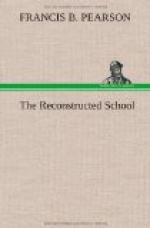Happy is the child whose teacher possesses imagination; who can touch the common things of life with the magic wand of her fancy and invest them with supreme charm; who can peer into the future with her pupils and help them translate the bright dreams of today into triumphs in the realms of art, music, science, philosophy, language, and philanthropy; and who builds air-castles of her own and thus has the skill to help the children build theirs. It is not easy, if, indeed, it is possible, for the teacher to quicken imagination in her pupils unless she herself is endowed with this animating quality. Dr. Henry van Dyke puts the case thus: “I care not whether a man is called a tutor, an instructor, or a full professor; nor whether any academic degrees adorn his name; nor how many facts or symbols of facts he has stored away in his brain. If he has these four powers—clear sight, quick imagination, sound reason, strong will—I call him an educated man and fit to be a teacher.” And, of a surety, imagination is not the least of these.
To this end every teacher should use every means possible to keep her imagination alive and luxuriant, and never, on any account, permit the exigencies of her task to repress it. The success of her pupils depends upon her, and she should strive against stagnation as she would against death. The passing out, the evaporation of imagination is an insidious process, and when it is gone she is but a barren fig-tree. If her imagination is strong and healthy she cannot have a poor school and her pupils will bless her memory throughout the years. As applying to every grade of school we may well note the words of Van Dyke: “Every true university should make room in its scheme for life out-of-doors. There is much to be said for John Milton’s plan of a school whose pupils should go together each year on long horseback journeys and sailing cruises to see the world. Walter Bagehot said of Shakespeare that he could not walk down a street without knowing what was in it. John Burroughs has a college on a little farm beside the Hudson; and John Muir has a university called Yosemite. If such men cross a field or a thicket they see more than the seven wonders of the world. That is culture. And without it, all scholastic learning is arid, and all the academic degrees known to man are but china oranges hang on a dry tree.” And without imagination this type of culture is impossible.
All reforms and, indeed, all progress depend upon imagination. We must be able to picture the world as it ought to be before we can set on foot plans for betterment. It is the high province of the imagination to enter into the feelings and aspirations of others and so be able to lend a hand; to build a better future out of the materials of the present; to soar above the solemnities and conventions of tradition and to smile while soaring; to see the invisible and touch the intangible; and to see the things that are not and call them forth as realities. Seeing that the business man, the fertile-brained essayist, and the gifted poet agree in extolling the potential value of imagination, we have full warrant for according to it an honored place in the curriculum of the school. Too long has it been an incidental minor; it is now high time to advance it to the rank of a major.




